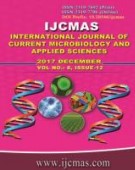


 National Academy of Agricultural Sciences (NAAS)
National Academy of Agricultural Sciences (NAAS)

|
PRINT ISSN : 2319-7692
Online ISSN : 2319-7706 Issues : 12 per year Publisher : Excellent Publishers Email : editorijcmas@gmail.com / submit@ijcmas.com Editor-in-chief: Dr.M.Prakash Index Copernicus ICV 2018: 95.39 NAAS RATING 2020: 5.38 |
The present investigation was carried out with the objective of the production of mango and guava bars fortified with protein having good sensory quality and high nutritional value and suitable for direct eating as a replacement of the confectionary and snacks which has no nutritional value. The results indicated that the optimum concentrations of sugars were 20% and 15% to be blended with mango and guava pulps, respectively followed by drying at 65°C to moisture content of 15-20%. Sulphiting treatment of mango and guava pulps to the levels of 1500 and 1000 ppm, respectively was necessary to produce fruit bars with good natural colors. Testing the food stabilizers data showed that adding 1.5% of pectin to mango pulp and 0.5% carboxy methyl cellulose to guava pulp are the more suitable conditions to produce fruit bars, respectively with good texture and chewability properties. Protein fortification indicated that using milk protein concentrate with concentration of 1.0% was preferred to produce protein fortified mango bar, while in the case of guava 2.0% of whey protein concentration was the more suitable. Sensory evaluation and chemical analysis indicated the possibility of producing protein fortified mango and guava bars with good sensorially properties and high nutritional values due to their high contents of sugar, protein, amino acids, vitamin C, β – carotene and minerals as well as well as fibers. The products showed high storage stabilities chemically, sensorially and microbiologically.
 |
 |
 |
 |
 |